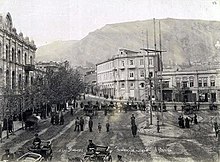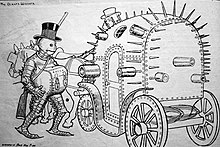Raid on the Bank of Tbilisi
The raid on the bank of Tbilisi was a politically motivated Raubtat in 1907 that the most important events in the early history of the Bolshevik direction of the Social Democratic Party of Russia counts.
The operation, carried out with extremely brutal use of force, cost several human lives and at the time caused a worldwide sensation. From today's perspective, it is particularly noteworthy as the first “political act” of far-reaching significance in the career of the young Josef Stalin , who at that time still had the name Josef Vissarionowitsch Dschugashvili and who organized and led the attack.
Course of the raid
prehistory
Since the revolutionary unrest of 1905 , there have been repeated spectacular, ruthless bank robberies by revolutionary groups in Russia that have also attracted international attention. For example, “the Russian bank robberies” were already a household name in the German press in the year before the attack in Tbilisi .
The main motive of the Bolshevik group was generally believed to be to raise money to finance their struggle against the tsarist state order. In addition, terrorist motives could have played a role, insofar as the strong public echo triggered by the brutality and efficiency of the attacks was accepted with approval.
The attack on the Bank of Tbilisi was commissioned by Vladimir Ilyich Lenin , the leader of the Bolshevik group within the Russian Social Democracy, who commissioned his Georgian follower Josef Jugashvili, who later became known under the name of Stalin, to plan and carry out the action. It is unclear exactly when the future dictator began preparing for the action, but various biographers such as Montefiore estimate a lead time of "several months" which is not specified.
In any case, preparations for the raid were already in progress when Jugashvili took part in a conference of the Russian Social Democrats in London in May 1907 , at which the Menshevik majority faction of the party passed a resolution condemning bank robberies as a means of political struggle and foreign exchange .
June 26, 1907
The raid finally took place after his return to Georgia on June 26, 1907. On the morning of that day, around 10:30 a.m., Dschugashvili and his group of activists, consisting of around twenty men and women, intercepted a cash transport from the Russian State Bank , consisting of two horse-drawn armored cars and a small division of mounted Cossacks , when the latter was on the forecourt of the Reichsbank branch from Tbilisi at Yerevanplatz. While the first car contained the foreign currency to be transported - accompanied by two bank officials and two guards - the second served as a wagon for an escort group of police officers and soldiers.
The attack on the small convoy began with a concerted throwing of heavy shells at the armored vehicles, in which large parts of the accompanying personnel and their horses were killed or mutilated. Attacks on the Cossacks and policemen patrolling the surrounding streets began almost at the same time.
Despite an unexpected complication - when an apparently dead draft horse galloped away in the money transporter - the Georgian revolutionary Kamo (1882–1922), one of the main protagonists of the event, said it was over in "just under three minutes".
According to official information, five people were killed. According to Simon Sebag Montefiore , the Ochrana archives show that a total of 50 people were injured and around 40 were killed.
consequences
The perpetrators escaped with a booty of around 250,000 rubles , which, according to Montefiore, roughly corresponded to the allowance that the Russian Tsar Nicholas II received annually at the time. Kamo soon smuggled the money into Finland , where he passed it on to Lenin, who used it largely to fund his further activities.
The action, of which Lenin officially claimed to have had nothing to do with it, accelerated the further drifting apart of the Russian Social Democracy, which had been split into two wings since 1903, which ultimately led to the two wings becoming independent as new parties in 1912. The bloody act met with widespread coverage in the international press, including in the editions of the London daily newspaper The Times on June 27 and 29.
literature
Archival material
- Stanford, Paris Okhrana Archives, box 209, folder XXB. 1 and XXB. 2.
Monographs and Articles
- Thomas Parschik: Kamo, bank robbers of the revolution in Das Blättchen , 20th year, No. 7 from March 27, 2017
- Roy Stanley De Lon: Stalin and social democracy, 1905-1922. The political diaries of David A. Sagirashvili . University Microfilms, Ann Arbor MI 1074, (Washington, DC, Diss., 1974).
- Simon Sebag Montefiore : The young Stalin . S. Fischer, Frankfurt am Main 2007, ISBN 978-3-10-050608-5 .
- Edward Ellis Smith: The Young Stalin. The early years of an elusive revolutionary . Farrar - Straus - Giroux, New York NY 1967.
Web links
Individual evidence
- ^ Report in the Vossische Zeitung of October 17, 1906.
- ↑ Joseph Stalin. Tabular curriculum vitae in the LeMO ( DHM and HdG )


